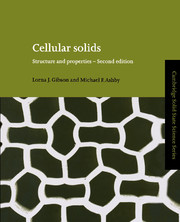Book contents
- Frontmatter
- Contents
- Preface to the second edition
- Preface to the first edition
- Units and conversion tables
- Chapter 1 Introduction
- Chapter 2 The structure of cellular solids
- Chapter 3 Material properties
- Chapter 4 The mechanics of honeycombs
- Chapter 5 The mechanics of foams: basic results
- Chapter 6 The mechanics of foams: refinements
- Chapter 7 Thermal, electrical and acoustic properties of foams
- Chapter 8 Energy absorption in cellular materials
- Chapter 9 The design of sandwich panels with foam cores
- Chapter 10 Wood
- Chapter 11 Cancellous bone
- Chapter 12 Cork
- Chapter 13 Sources, suppliers and property data
- Appendix: The linear-elasticity of anisotropic cellular solids
- Index
- References
Chapter 13 - Sources, suppliers and property data
Published online by Cambridge University Press: 05 August 2014
- Frontmatter
- Contents
- Preface to the second edition
- Preface to the first edition
- Units and conversion tables
- Chapter 1 Introduction
- Chapter 2 The structure of cellular solids
- Chapter 3 Material properties
- Chapter 4 The mechanics of honeycombs
- Chapter 5 The mechanics of foams: basic results
- Chapter 6 The mechanics of foams: refinements
- Chapter 7 Thermal, electrical and acoustic properties of foams
- Chapter 8 Energy absorption in cellular materials
- Chapter 9 The design of sandwich panels with foam cores
- Chapter 10 Wood
- Chapter 11 Cancellous bone
- Chapter 12 Cork
- Chapter 13 Sources, suppliers and property data
- Appendix: The linear-elasticity of anisotropic cellular solids
- Index
- References
Summary
Introduction and synopsis
Manufacturers of foams produce data-sheets, listing their properties. We have assembled a database of available foams and their suppliers, and illustrate it here. The foams and their suppliers are cataloged in the Appendix 13 A, as Tables 13.A1 and 13.A2. The first lists foams by chemistry and trade name, attaching a manufacturer or supplier code to each. The second relates this code to a company, an address, and, where possible, a telephone and fax number. The contents of the tables are based on information obtained from suppliers in 1995. Products, of course, evolve and develop, and new manufacturers and materials appear, so a completely up-to-date compilation is not possible. But this catalogue gives a starting point.
Data-plots are used to illustrate the range of foams properties. Two case studies illustrate methods of selecting foams for specific applications.
The compilation of materials and suppliers
There are three main difficulties in locating a given foam for a given engineering application. First, there are almost no standards, either national or international. Second, foams and cellular solids are marketed under weird trade names (‘Neopolen’, ‘Cellobond’) which give little guidance in identifying either their chemistry or their supplier. And third, while some large-volume foams are widely marketed by well-known multi-nationals, many are the products of small, specialized producers, not otherwise known in the market place.
Information
- Type
- Chapter
- Information
- Cellular SolidsStructure and Properties, pp. 468 - 495Publisher: Cambridge University PressPrint publication year: 1997
